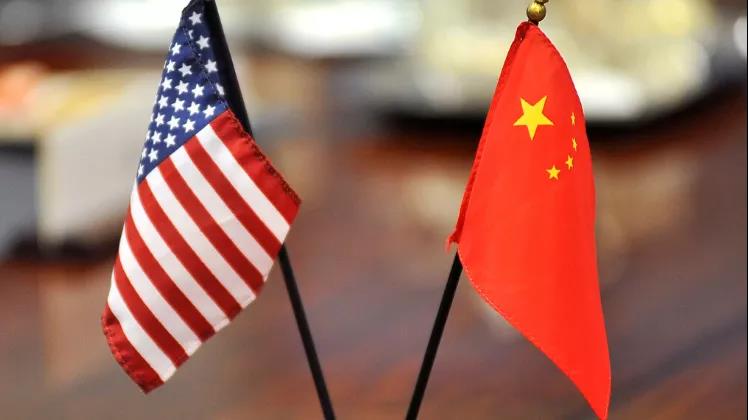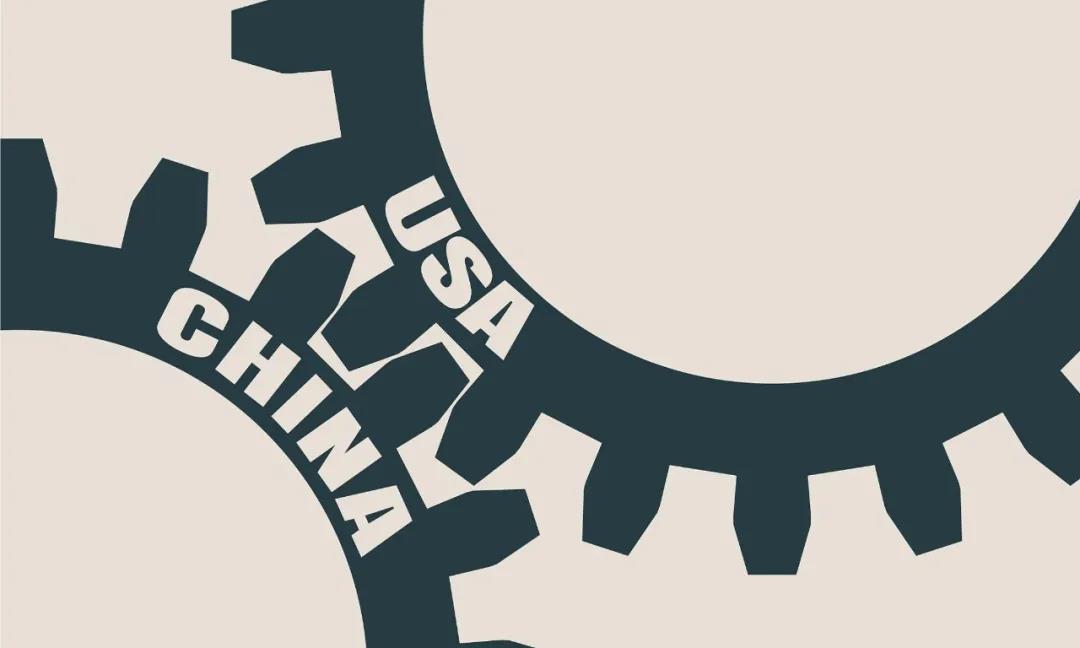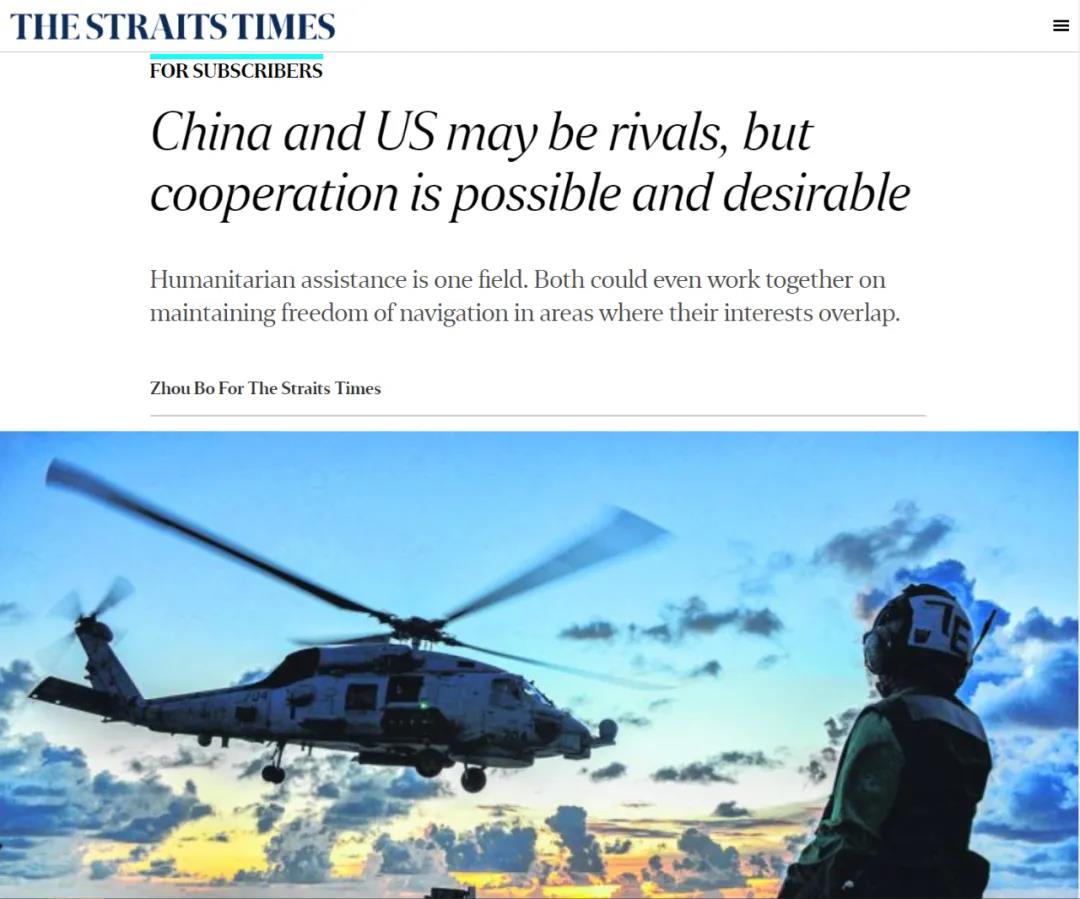编者按
清华大学战略与安全研究中心研究员、中国论坛特约专家周波日前在新加坡《海峡时报》撰文“中国和美国或许是对手,但合作是可能且可取的”(原标题“China and US may be rivals, but cooperation is possible and desirable”)。中国论坛受权翻译全文,并由清华大学战略与安全研究中心公众号转发,后附英文原文,以飨读者。
拜登将很快取代特朗普入主白宫,这不一定会让北京方面松一口气。无论拜登与特朗普个人有多么的不同,由特朗普政府发起并取得国会两党共识支持的大国竞争不仅将持续,而且在未来几十年中可能会加剧。
当然,没有什么比两个核大国之间的军事冲突更令人担忧的了,但是,鉴于台湾海峡和南海不断升温的紧张局势,这并非没有可能。
尽管中国人民解放军的军事实力总体上落后于美军,但是在西太平洋地区,这一差距正朝着有利于中国的方向缩小。2018年11月,美国国会成立的两党共同参与的国防战略委员会就警告称,若与中国就台湾问题开战,“美国可能面临决定性的军事失败”。
中国和美国都不想打仗。双方在建立信任措施方面达成了一些协议,例如《关于建立加强海上军事安全磋商机制的协定》和《中美海空相遇安全行为准则》,以及政府和军方的热线。但事实仍然是,事故照样会发生,就像2001年美国海军侦察机与中国战斗机在海南发生的撞机事件一样。在2001年、2009年、2013年、2014年、2015年和2018年,美国和中国的军舰和飞机也有多次近距离接触。
中美两国能否防止一场意外演变成双方都不愿看到的冲突?从这点上讲,中国国防部和美国国防部于2020年10月底成立了危机沟通工作组并举行了第一轮会谈,这是朝着正确方向迈出的一步。这是双方第一次承认中美之间可能爆发危机。

全球公域中的合作
对于中美两国来说,消弭冲突之道是将目光投向西太平洋以外的、双方利益有重叠的全球公域。在远离中国近海的地方,两国没有较量,合作是完全有可能的。
中美合作甚至有助于缓解两国长期以来在航行自由等方面的分歧。尽管北京反对美国海军在南海及中国近岸附近水域进行的“航行自由”行动,认为其对中国的安全构成了威胁,但是在诸如亚丁湾这样的地方,情况就不同了。在那里,中美海军联手其他国家的海军一起进行反海盗巡逻,以维护航行自由。
由于90%的国际贸易是通过海运进行的,中国作为世界上最大的出口国和第二大进口国,与美国一样,在国际海上通道的安全方面有着至关重要的利益。
如果中美两国海军能在亚丁湾成功合作,为什么不把这种合作扩大到海盗仍然猖獗的几内亚湾和苏禄海的公海上呢?
实际上,随着中国走向全球,她与美国的共同利益越来越多了。
中国此前曾表示,也值得在此重申,中国无意取代美国成为世界领袖或全球警察,也不寻求输出其意识形态或发展模式。
中国海军的发展已经取得了很大成就。如今,在舰船和潜艇数量上,中国海军已经超过了美国海军,解决台湾或南海问题绰绰有余。但必须指明的是,推动建设蓝水海军是保护中国无处不在的海外投资、商业资产和中国公民的必要举措,也能让中国承担起一个大国义不容辞的国际义务。
中国军队和美军可以合作的另一个领域是人道主义行动。在拜登担任副总统的奥巴马政府期间,两国讨论过向非洲维和人员提供联合援助的问题,但在特朗普于2017年就职后,对话终止了。
中美合作的空间很大,包括那些看似非军事的、但实际上与安全问题紧密相关的合作。例如,2014年,中国和美国科学家在塞拉利昂的一间中国实验室里并肩工作,研究埃博拉病毒。新冠肺炎疫情的蔓延在全球已造成了160多万人死亡,这清楚地表明,流行病等“非传统”威胁甚至可能比一场大战更加致命。更重要的是,这也说明中美两个大国为什么应该再次携手。

其他需要合作的领域
随着中国和美国军队之间差距的缩小,终有一天,两军必须讨论战略平衡的问题。
美国现在希望达成一项包括中国、美国和俄罗斯在内的多边核裁军协议。考虑到该协议会有多么不平衡,中国是不会同意的。美国和俄罗斯各自拥有超过6000枚核弹头。就算中国能够发射到美国的陆基洲际弹道导弹弹头数量,如五角大楼在今年提交给国会的报告中所预测的那样,在未来五年内将增长到大约200枚,美国对中国的这种提议听起来也像是一个胖子邀请一个很瘦的人一起减肥。
在核问题上,如果中美两国能像北京提议的那样,转向讨论互不首先使用核武器,岂不是更好吗?互不首先使用核武器不会降低美国在核力量和常规力量方面的整体优势。尽管北京力争要在本世纪中叶建成“世界一流军队”,但根据北京自己的路线图,解放军还需要30年时间才能接近美军的水平。
在网络战、太空、人工智能等新军事领域,解放军与美军的差距就比较小了。但是,若要让中国和美国开始讨论这些问题,美国就必须首先取消对与解放军交流的法律限制。
自2000年以来,美国法律就限制美军在行动层面与解放军开展交流,因为担心这些交流可能有助于提升解放军的作战能力,并“造成国家安全风险”。
但是解放军在过去20年取得的巨大进步表明,它不一定需要与美军交流才能提高能力。根据五角大楼的说法,“中国在某些领域已经领先于美国”,例如在造船、陆基常规弹道导弹和巡航导弹,以及综合防空系统等方面。
如果中国和美国陷入新的冷战,那真是太不幸了。即便华盛顿的气氛仍然是大国竞争,双方也必须努力避免竞争滑向对抗,要做到这一点,方法仍然是合作,即寻找并抓住任何可能合作的机会。
翻译 | 中国论坛 许馨匀
校译 | 中国论坛 韩桦

China and US may be rivals, but cooperation is possible and desirable
That Mr Joe Biden will soon occupy the White House instead of Mr Donald Trump will not necessarily elicit sighs of relief in Beijing. However different Mr Biden might be from Mr Trump personally, the great power competition initiated by the Trump administration and backed by a bipartisan congressional consensus will not only remain on course but also likely intensify in the decades to come.
Of course, nothing is more worrisome than a military conflict between two nuclear powers, but this is not impossible, given rising tensions in the Taiwan Straits and the South China Sea.
Although the People's Liberation Army's (PLA) military strength lags behind that of the US military in general, in the West Pacific, the gap is closing in China’s favour. In November 2018, the bipartisan National Defence Strategy Commission set up by the US Congress warned that in a war with China over Taiwan, “Americans could face a decisive military defeat”.
Neither China nor the US wants a war. Both have a few agreements on confidence building measures such as the Military Maritime Consultative Agreement and the Rules of Behaviour for Safety of Air and Maritime Encouters and hotlines both at governmental and military levels. But the fact remains that accidents can happen, as with the deadly collision of a United States Navy surveillance plane with a Chinese fighter jet off Hainan in 2001. There have also been quite a few close encounters between American and Chinese military vessels and aircraft, in 2001, 2009, 2013, 2014, 2015 and 2018.
Could the two countries prevent an accident spilling over into a conflict neither wants to see? In this regard, the setup and the first round of talks of the Crisis Communications Working Group between the Chinese Ministry of National Defence and US Department of Defence in late October is a move in the right direction. It’s the first time both sides acknowledged that a crisis could break out between them.
COOPERATION IN GLOBAL COMMONS
For China and the US to deconflict, the way forward is to look beyond the Western Pacific into the global commons where their common interests overlap. Away from China’s near sea, the two are not at loggerheads and cooperation is entirely possible.
China-US cooperation could even help to mitigate their longstanding disagreements on, say, freedom of navigation. While Beijing opposes the US Navy's freedom of navigation operations in the South China Sea and waters close to its shores, seeing them as a threat to China's security, things are different in places such as the Gulf of Aden, where the two navies have joined other international navies in counterpiracy patrols to maintain freedom of navigation.
As 90 per cent of international trade is seaborne, China, being the largest exporter and the second-largest importer in the world, has vital interests in the security of international sea lanes, like the US.
If the Chinese and American navies can cooperate successfully in the Gulf of Aden, why not extend such cooperation to, say, the high seas of the Gulf of Guinea and the Sulu Sea, where piracy is still rampant?
In fact, as China goes global, it finds itself sharing increasingly common interests with the US.
China has said previously and it bears repeating here, that it has no intention to replace the US as a world leader or global cop. Nor does it seek to export its ideology or development model.
Much has been made of the growth of the PLA Navy, which today outnumbers the US Navy in ships and submarines. Its vessels are more than enough to solve China's Taiwan or South China Sea issues, but it is important to note that the push to build a blue water navy is a necessary move to protect China's ubiquitous investments, commercial assets and nationals overseas. It also enables China to shoulder the international obligations that are incumbent upon a major power.
Another area where the PLA and the US military could cooperate is in humanitarian missions. During the Obama administration when Mr Biden was vice-president, both countries discussed providing joint assistance to African peacekeepers, but the talks were scrapped after Mr Trump took office in 2017.
There is much scope for Sino-US cooperation, including ones that seem non-military but are indeed security-related. For example, in 2014, Chinese and American scientists worked side by side in a Chinese laboratory on Ebola in Sierra Leone. The spread of Covid-19 with a death toll of over 1.6 million people worldwide shows clearly how “non-traditional” threats such as pandemics could be far more lethal even than a major war and, more importantly, why the two major powers should join hands once again.
WORK NEEDED IN THESE AREAS
As the gap between the Chinese and the US militaries shrinks, the day will come when they have to discuss strategic equilibrium.
The US now wants a multilateral nuclear disarmament agreement involving China, the US and Russia. China will not agree to this given how lopsided the deal would likely be. Both the US and Russia have over 6,000 nuclear warheads each. Even if the number of warheads on China's land-based intercontinental ballistic missiles capable of reaching the United States grow to roughly 200 in the next five years, as the Pentagon predicted in its report to Congress this year, such an American proposal to China sounds like a fat man inviting a lean man to go on a diet together.
On the nuclear issue, would it not be better if China and the US moved to discuss non-first use of nuclear weapons, as Beijing has proposed? No-first-use won't reduce the overall superiority of the US in both nuclear and conventional forces. Even though Beijing has vowed to build a "world-class military" by the mid-century, it would take the PLA another 30 years to come close to matching the US military, according to Beijing's own road map.
But in new military domains such as cyberwarfare, space and artificial intelligence, the gap between the PLA and the US military is smaller. But for China and the US to even start talking about these issues, the US has to lift the legal restrictions on exchanges with the PLA first.
Since 2000, American laws have restricted exchanges with the PLA in operational areas for fear that they might contribute to the PLA’s war-fighting capabilities and “create a national security risk”.
But the tremendous progress of the PLA in the last two decades demonstrates that it doesn't necessarily need exchanges with the US military to grow in strength. According to the Pentagon, "China is already ahead of the United States in certain areas" such as in ship building, land-based conventional ballistic and cruise missiles and integrated air defence systems.
It would be most unfortunate if both China and the US were to slide into a new cold war. Even if the mood in Washington is one for big power competition, both sides must strive to avoid the contest sliding into confrontation, and the way to do so is still cooperation, looking for it and engaging in it wherever the opportunity arises.
Senior Colonel (Ret) Zhou Bo is a senior fellow at the Centre for International Security and Strategy, Tsinghua University, and a China Forum expert.

